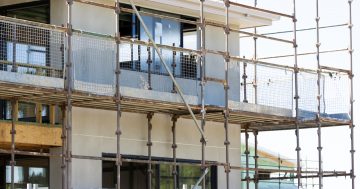
Chief Minister Andrew Barr and Housing Minister Yvette Berry talk to the media on Monday. Photo: George Tsotsos.
Welfare groups have welcomed the ACT Government’s $100 million Housing Strategy as a significant commitment and a good start to increasing the supply of affordable public and social housing in the Territory.
Chief Minister Andrew Barr and Housing Minister Yvette Berry unveiled the strategy on Monday in Belconnen, with a boost to public housing over the next five years and 15 per cent of all land releases set aside for affordable housing the highlights.
ACT Council of Social Services Director Susan Helyar said she was pleased that the Government had recognised the scale of the problem for the ACT’s lowest income group and the need to improve the quantity and quality of public housing.
With public housing down to only 7 per cent of the overall housing supply, it was a good place make a significant investment, she said.
“It will be hard for it to be enough in the short term, but we see any investment as welcome, and with the 15 per cent target for new developments and the 151 new dwellings for community housing on top of those 15 per cent targets it will get us to a better place than we are now,” Ms Helyar said.
She said it was important that the 15 per cent ‘inclusionary zoning’ target included both greenfield and brownfield sites, a view echoed by ACT Shelter’s Travis Gilbert who said it meant that people may not be priced out of transport corridors close to jobs and services.
Ms Helyar said it was pleasing to see specific actions and a reporting framework but ACTCOSS will be calling on the Government to set up a formal mechanism through which it can continue to engage with stakeholders and ensure the strategy rolled out in a way that made sense and honoured its objectives.
“The main challenge will be working though some of the more complicated detail – lease variation charge remissions, the build to rent program and how to make sure there is access to land that is affordable,” she said.
“The two things we’ve said consistently is the need for $100 million and that the strategy delivers thousands not hundreds of affordable homes, and we can see that there is scope for that to happen over the next the next four years,” she said.
Ms Helyar said ACTCOSS welcomed the incorporation of the tenancy law reform that was needed in the private sector rental market, into the strategy.
She said that while crisis accommodation was important, unless long-term affordable places for people to live were being built, there can be an endless demand for temporary accommodation that can never be met.
Ms Helyar backed Mr Barr’s attack on negative gearing combined with capital gains tax concessions, saying it was absolutely vital to turning things around that we treat people who are looking for a house and place to live as more of a priority than people who are generating wealth out of investment properties.
It was also important for the Commonwealth not to leave affordable housing measures to the states, territories and local government.
Mr Gilbert said the strategy was a great start, particularly the 15 per cent inclusionary zoning component, but it was not going to provide the 6000 affordable homes that the Economic Development Directorate had identified as the gap in supply for people earning under $90,000 a year.
But he said several community housing providers in the ACT could benefit from the Commonwealth Housing Finance Investment Corporation, from which they could borrow at bond rates to build new homes, although with the yield gap between the 6-7 per cent return that investors expected and the 4-5 per cent return that housing provides, it was important for government to have skin in the game.
“What’s needed is the government or someone to step in and bridge the 1-3 per cent gap between what an investor expects and what housing pays as an investment price,” he said. “Government clearly has a responsibility to fully fund the cost of housing for people who can’t afford to participate in the market.”
He was pleased that the Government backed away from earlier plans to go down the NSW track of taking away the security of tenure from public tenants.
Mr Gilbert said that without reforms to the Residential Tenancies Act, private rental tenure was not appropriate or stable enough for someone with any reasonable history of homelessness.
Safe Shelter’s Richard Griffiths, who has been calling for more temporary walk-in crisis accommodation, said the strategy did not address the needs of people living on the streets.
But the Managing Director of Havelock Housing, Neil Skipper, said that the 151 new community housing dwellings would free up beds for people needing crisis accommodation.
“We will be able to help a lot of people that need our help and actually be able to offer places to people who can’t get private accommodation,” he said.
Master Builders ACT also welcomed the release of the Housing Strategy but warned that all ACT Directorates must pull in the same direction and against any changes to federal tax policy.
“When Treasury quadruples the Lease Variation Charge applying to certain residential leases as occurred 12 months ago, when there are delays to the implementation of building quality reforms, and if changes to negative gearing and Capital Gains Tax are implemented as proposed by Federal Labor, there are direct contradictions to the aims of the strategy released today,” said CEO Michael Hopkins.





















